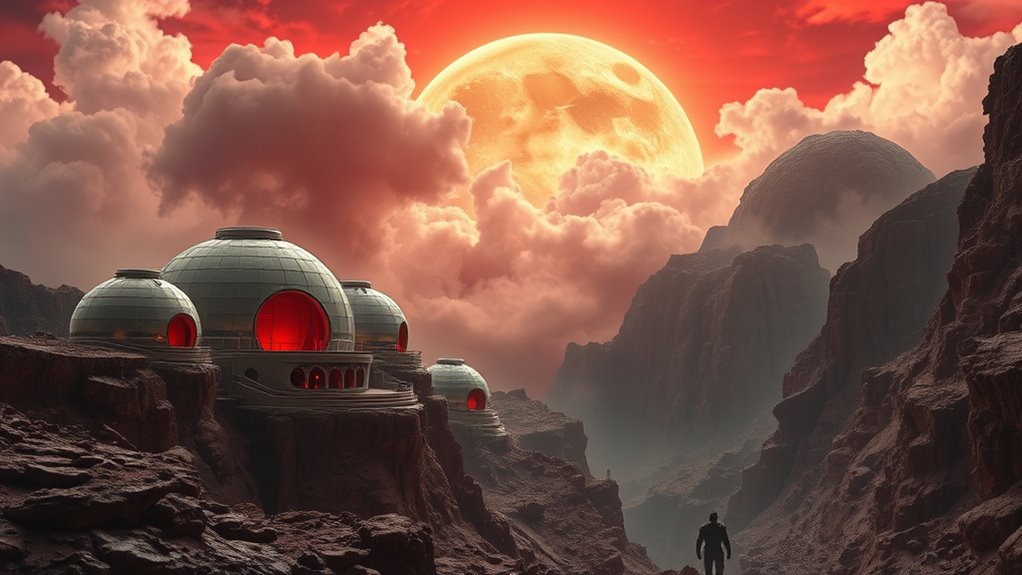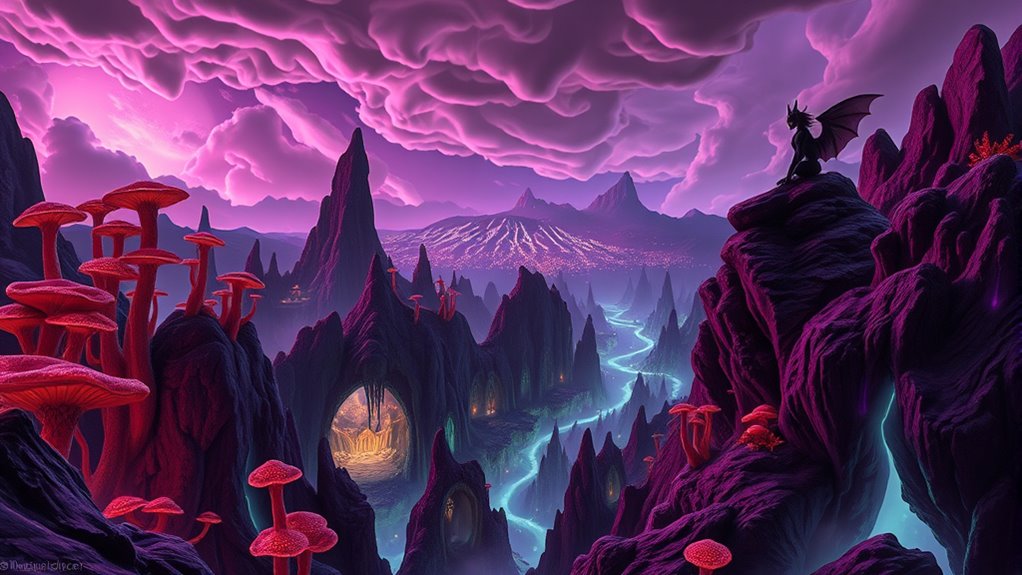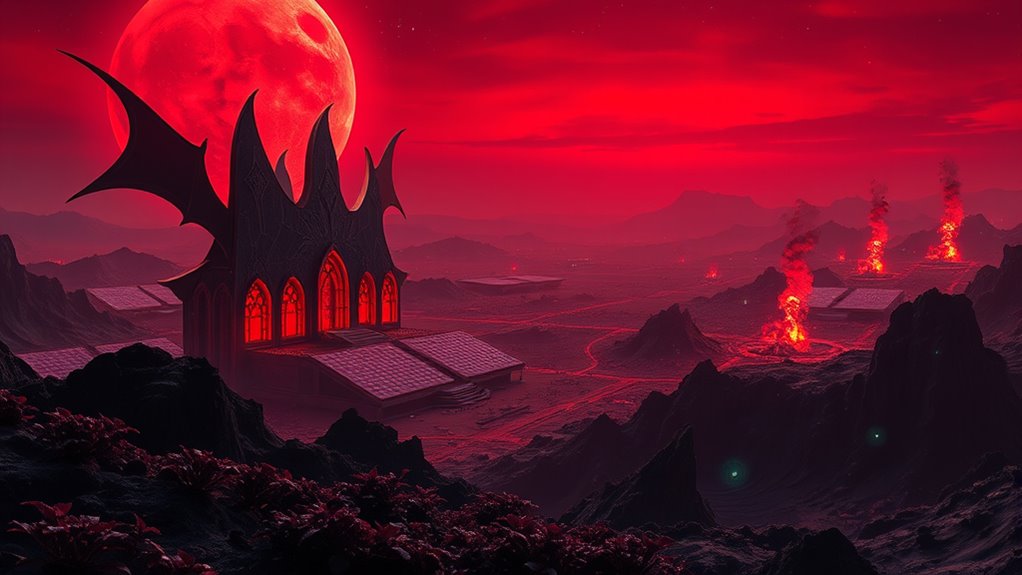Transforming Venus into a haven for vampires involves multiple steps. You’d start by creating a darkness-promoting atmosphere with reflective particles to block sunlight and maintain long-term shadows. Next, you’d modify surface temperatures with solar collectors or reflective materials, and develop pressure-resistant habitats with biological adaptations for extreme conditions. Sustainable energy sources like solar or geothermal power would support your colony, while addressing ecological risks and ethical considerations. Want to learn how all these elements come together? Keep exploring.
Key Takeaways
- Modifying Venus’s surface temperature and atmosphere to create a stable, dark environment suitable for vampire adaptation.
- Introducing atmospheric aerosols and reflective particles to block sunlight and maintain perpetual darkness.
- Developing biological traits in vampires for extreme resilience against high temperatures, toxic gases, and radiation.
- Constructing pressure-resistant habitats with advanced shielding to sustain life amid Venus’s extreme surface conditions.
- Addressing ethical and ecological considerations to prevent planetary destabilization and preserve potential intrinsic planetary value.
Assessing Venus’s Original Environment and Challenges

Venus’s original environment posed significant obstacles to any form of life or colonization. Its intense volcanic activity constantly reshapes the planet’s surface, releasing gases and creating a hostile landscape. Historically, Venus’s atmosphere composition was thick with carbon dioxide, with clouds of sulfuric acid that made the surface nearly impossible to access. The planet’s surface temperature soared due to a runaway greenhouse effect, trapping heat relentlessly. These conditions resulted in a crushing pressure at the surface—over 90 times that of Earth’s—making it an extreme environment. Understanding Venus’s volcanic activity and its historical atmosphere composition reveals why early colonization efforts failed and highlights the immense challenges in transforming this hostile world into a livable space.
Designing a Darkness-Promoting Atmosphere

To create an atmosphere that promotes darkness, you need to maximize shadow coverage and absorb as much solar radiation as possible. This involves selecting materials and structures that block or reflect light efficiently. By controlling light levels, you can guarantee the nighttime environment stays suitably shadowy for vampire habitats.
Maximizing Shadow Coverage
Have you considered how atmospheric composition can be manipulated to maximize shadow coverage on Venus? By increasing aerosols or reflective particles, you can create a denser, darker atmosphere that blocks sunlight more effectively. This sustained darkness benefits bat habitats and nocturnal ecosystems, encouraging creatures that thrive in shadows. To achieve this, you might:
- Introduce thick, dark aerosols that scatter sunlight away from the surface
- Use reflective atmospheric layers to bounce light back into space
- Adjust atmospheric gases to sustain a perpetual twilight, deepening shadows
These modifications assure extended periods of darkness, supporting vampire-friendly environments and nocturnal biodiversity. Such an atmosphere not only fosters shadow coverage but also stabilizes the conditions needed for a thriving, shadow-dependent biosphere.
Absorbing Solar Radiation
Building on the idea of maximizing shadow coverage, manipulating atmospheric properties to absorb solar radiation can deepen darkness even further. You can achieve this through advanced radiation management techniques that enhance solar absorption. By introducing dark, high-albedo particles or aerosols into the atmosphere, you increase the atmosphere’s capacity to soak up sunlight before it reaches the surface. Reflective surfaces are minimized, while absorbing particles are optimized for maximum solar energy capture. This process reduces surface illumination, creating a perpetual dim environment suited for vampires. Precise control of atmospheric composition allows you to limit incoming radiation efficiently, ensuring minimal light penetrates, and maintaining the darkness necessary for your nocturnal inhabitants. Effective radiation management becomes essential in creating an environment of sustained, unrelenting darkness.
Enhancing Nighttime Darkness
Creating an atmosphere that promotes maximum darkness requires actively manipulating atmospheric components to block out residual light. You’ll aim to reduce atmospheric scattering and reflectivity, ensuring the night sky remains pitch black. This fosters moonlit biomes, where nocturnal adaptations thrive in the absence of bright light. To achieve this, you might introduce dense aerosols that absorb or deflect stray photons or deploy reflective shields to minimize atmospheric glare. Consider the following:
- Thick, light-absorbing aerosols to minimize residual glow
- Reflective layers to redirect stray light away from the surface
- Cloud formations designed to trap and prevent light escape
These measures create an environment where vampires and nocturnal creatures flourish, thriving in an unrelenting darkness that enhances their natural adaptations.
Modifying Surface Conditions for Extreme Temperatures

To create an environment suitable for vampires, you’ll need to achieve extreme heat on Venus’s surface. Managing this intense temperature requires controlling the surface atmosphere and its interactions with solar radiation. How you handle these factors will determine whether the planet becomes a suitable domain for your dark ambitions.
Achieving Extreme Heat
Achieving extreme heat on Venus requires a deliberate manipulation of its surface and atmospheric conditions to trap more solar energy. You can do this by enhancing solar absorption and reducing heat loss. Deploying large-scale solar collectors will maximize energy intake, while reflective surface materials can trap heat efficiently. To prevent solar wind from stripping away essential atmospheric gases, you’d install powerful magnetic shielding, mimicking a magnetic field. This shield directs solar wind particles away, preserving the atmosphere’s density and heat-retention capacity. Visualize a planet with a thick, heat-absorbing crust and an atmosphere thick with greenhouse gases, continuously amplifying surface temperatures. The magnetic shield acts as a barrier, ensuring the planet’s surface remains exposed to maximum solar radiation, driving up temperatures to extreme levels suitable for vampires.
Managing Surface Atmosphere
Manipulating surface conditions directly influences Venus’s ability to sustain extreme heat. By adjusting atmospheric composition, you can control surface temperatures essential for vampire survival. Introducing alien flora that absorbs heat or reflects sunlight can help moderate temperatures. Celestial mechanics, like shifting Venus’s rotation or orbit, could also influence heat distribution. To visualize options:
| Method | Effect |
|---|---|
| Reflective aerosols | Reduce surface heat via sunlight reflection |
| Alien flora | Absorbs or redirects heat, stabilizing temps |
| Orbital adjustments | Change insolation patterns, cooling surface |
| Atmospheric gases | Trap or release heat, managing extremes |
Your goal is to balance extreme heat, ensuring the surface remains habitable for your vampire ecosystem while preventing runaway temperature rises.
Developing Pressure-Resistant Structures and Ecosystems

Since Venus’s extreme atmospheric pressure and corrosive environment pose significant challenges, developing pressure-resistant structures and ecosystems becomes essential for any terraforming effort. You must create habitats that withstand crushing pressures and prevent atmospheric degradation. These structures need advanced materials to ensure durability and safety. Climate stabilization depends on maintaining the right atmospheric composition inside habitats, shielding inhabitants from Venus’s harsh exterior. To achieve this, you’ll incorporate cooling systems and corrosion-resistant alloys. Consider these key elements:
Develop pressure-resistant habitats with advanced materials, cooling, and corrosion-resistant alloys to survive Venus’s extreme environment.
- Reinforced, multi-layered domes with pressure-equalizing vents
- Subsurface ecosystems insulated from surface conditions
- Automated systems for atmospheric regulation and corrosion control
Designing resilient ecosystems will help sustain life, supporting the goal of stabilizing the climate and maintaining safe atmospheric conditions for vampires. Your focus remains on creating sustainable, pressure-equalizing environments amid the planet’s extreme environment.
Introducing Biological Adaptations for Vampire Survival

To guarantee vampires can survive on Venus, biological adaptations must complement the engineered habitats. You’ll focus on enhancing biological resilience, enabling your vampire population to withstand extreme conditions like high temperatures and toxic atmospheres. Evolutionary adaptations will be essential; over generations, vampires could develop traits such as radiation tolerance, UV resistance, and metabolic shifts to optimize energy intake in the Venusian environment. These adaptations could include specialized skin that reflects heat or filters harmful rays, and internal systems that conserve water and nutrients. By fostering these biological traits, you assure vampires become self-sustaining entities capable of thriving beyond initial technological support. This integration of biology and engineering creates a robust survival strategy tailored specifically to Venus’s hostile environment.
Engineering Sustainable Energy and Resource Systems

Creating sustainable energy and resource systems on Venus requires innovative engineering solutions that can operate efficiently in the planet’s extreme environment. You must harness Venus’s unique features, like its magnetic field, to protect infrastructure from intense solar radiation. Adjusting the atmospheric composition becomes essential to support energy generation and resource extraction. You might develop magnetically shielded energy stations that utilize solar or geothermal power. Additionally, atmospheric manipulation could enhance resource availability or reduce harmful gases.
Innovative engineering on Venus harnesses magnetic fields and atmospheric manipulation to enable sustainable energy and resource systems.
- Deploy magnetically shielded solar arrays to capture sunlight effectively.
- Use atmospheric processing to extract critical gases and stabilize the environment.
- Integrate magnetic field generators to safeguard energy infrastructure from radiation.
Addressing Potential Biological and Ecological Risks

Addressing potential biological and ecological risks on Venus is crucial to prevent unintended consequences from terraforming efforts. You must consider biological risks, such as introducing Earth organisms that could become invasive or disrupt existing planetary conditions. Ecological concerns also arise if altered environments favor certain species over others, leading to loss of native-like systems. Since Venus’s atmosphere and surface are vastly different from Earth, even minimal biological contamination could trigger unpredictable reactions. You’ll need strict containment protocols and thorough risk assessments to avoid creating harmful ecosystems or jeopardizing future colonization. Recognizing these risks ensures that terraforming processes remain controlled, minimizing damage to the planet’s evolving environment. Careful planning and monitoring help prevent ecological destabilization and safeguard against irreversible biological impacts.
Implications for Planetary Engineering and Ethical Considerations

When undertaking planetary engineering on Venus, you must carefully weigh the ethical implications of altering an entire world. Planetary ethics challenge you to deliberate whether such transformation respects the intrinsic value of the planet’s existing state. You also need to evaluate the ecological impact, including potential harm to unknown or undiscovered life forms. Altering Venus raises questions about humanity’s responsibility and the potential consequences for future generations.
- How do you balance progress with respect for natural planetary systems?
- What obligations do you have to preserve or protect the planet’s integrity?
- Is it ethical to modify a planet solely for specific species, like vampires, at the expense of broader ecological stability?
These considerations guide responsible decision-making in planetary engineering, emphasizing the importance of ethics alongside technological ambition.
Future Possibilities: Beyond Vampires in Space

Looking beyond the immediate goal of transforming Venus for vampire habitation opens up a domain of possibilities for humanity’s future in space. You could explore advanced space colonization, establishing thriving communities on moons or planets, and even seek signs of extraterrestrial life. This effort might *unlock* insights into biology, evolution, and the universe’s origins. Imagine creating self-sustaining habitats that support diverse life forms, fostering interstellar ecosystems. The table below illustrates potential future ventures:
| Mission Type | Goal |
|---|---|
| Lunar Colonization | Permanent settlements on the Moon |
| Mars Habitats | Red planet research stations and colonies |
| Asteroid Mining | Extracting resources for space expansion |
| Exobiology Research | Studying extraterrestrial life forms |
| Interstellar Travel | Reaching distant star systems |
These endeavors could redefine humanity’s place in the cosmos.
Frequently Asked Questions
Could Vampire Biology Evolve Naturally in Venus’S Environment?
You wonder if vampire biology could evolve naturally on Venus. Given Venus’s extreme heat, crushing pressure, and toxic atmosphere, vampire metabolism would need significant Venusian adaptations. Over millions of years, you might see creatures developing thick skins, efficient oxygen processing, and heat-resistant features. These Venusian adaptations could support a vampire-like metabolism, enabling survival in such harsh conditions, but it would require extraordinary evolutionary changes unlikely without human intervention.
How Would Vampire Social Structures Adapt to an Alien Ecosystem?
You’d see vampire social structures shift dramatically in an alien ecosystem. The vampire hierarchy might become more fluid, adapting to new challenges and resources like the Blood economy, which could depend on alien flora or fauna. As survival becomes key, social roles may blur, with some vampires taking on leadership based on knowledge of the environment rather than traditional dominance. This evolution would redefine how vampires organize and sustain their society.
What Legal Frameworks Govern Extraterrestrial Biological Modifications?
Imagine extraterrestrial patent laws are like the rules of a cosmic game you’re just learning. You’re governed by space biological rights that protect innovations beyond Earth, but these laws are still evolving. You must navigate international treaties and agreements that regulate biological modifications outside our planet. Staying compliant guarantees your work respects legal boundaries, helping you contribute responsibly to the future of space biotech and avoid legal pitfalls.
Are There Potential Unintended Ecological Consequences of Terraforming for Vampires?
You should consider that terraforming for vampires could cause ecological imbalance, disrupting existing ecosystems. Unintended mutations might arise in native species, leading to unpredictable consequences. These changes could threaten biodiversity and destabilize the environment. You might inadvertently create new invasive organisms or alter climate patterns, making the planet less hospitable. It’s essential to assess these risks thoroughly to prevent long-term ecological damage.
Could Other Mythical Creatures Be Feasibly Integrated Into Venus’S Environment?
You wonder if other mythical creatures could fit into Venus’s environment. It’s possible to imagine a mythical predator thriving alongside supernatural flora, creating a complex ecosystem. You’d need to contemplate how these beings interact with the environment and each other. While fantastical, integrating such creatures would require careful planning to balance the ecosystem, ensuring that these mythical predators and supernatural flora coexist without causing ecological chaos.
Conclusion
As you imagine transforming Venus into a vampire haven, remember that this dream is like chasing a moonbeam—beautiful but elusive. Though the challenges are formidable, your innovative spirit can push boundaries, shaping worlds beyond imagination. With each bold step, you breathe life into a vision that’s as dark and mysterious as the night itself. Keep dreaming, for in your hands, even the impossible becomes a shadow waiting to be cast.










